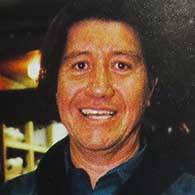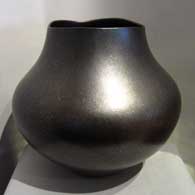
Lonnie Vigil
Nambé

"I prayed for direction from the Clay Mother and slowly the information began to come. I also asked for the help of my great-grandmother and my great-aunts, who were all potters. And I still ask their guidance today."
Born in May 1949, Lonnie Vigil said he had no conscious desire to become an artist when he was growing up at Nambe Pueblo. Instead, he finished high school and went on to earn a degree in business administration from Eastern New Mexico University. Then he pursued a career as a financial and business consultant, first at the Eight Northern Pueblos office in New Mexico and then at the Bureau of Indian Affairs in Washington, D.C.
By the early 1980s, he was becoming aware that his work and life in Washington "gave me nothing to feed my soul." A performance at the Kennedy Center called Night of the First Americans inspired him to return to Nambé.
At first he spent days wandering the pueblo lands and praying, seeking a vision to follow into his future. He discovered a source of micaceous clay on pueblo land, then he found polishing stones in the ruins of his grandparents' home. That's when he got his first inkling that the rest of his life would be "committed to the Clay Mother."
In the beginning, it was hard because there was no one to teach him. "I prayed for direction from the Clay Mother and slowly the information began to come," he says. "I also asked for the help of my great-grandmother and my great-aunts, who were all potters. And I still ask their guidance today."
Apparently he was guided into re-creating Nambé Pueblo's famous micaceous clay pottery. But Nambé potters used to use micaceous clay to seal their pots for use in cooking and storage while Lonnie has elevated the use of micaceous clay to the state of fine art.
He practiced working with micaceous clay until one day in 1994 he was declared the first recipient of the Ron and Susan Dubin Native American Artist Fellowship at the School for Advanced Research in Santa Fe. Upon receiving the fellowship, Lonnie said, "I am honored to be the first Dubin Fellow at such a fine institution as the School for Advanced Research. The Fellowship is an affirmation of the work I am doing." That support allowed him to take the time to study the ancient micaceous pottery in their collections.
Micaceous pottery is distinguished by the sparkling mica flecks naturally distributed in the clay. Historically, micaceous pottery was used for cooking and storage by the people of Nambé, Picuris, Taos and the Jicarilla Apache. Overlooked by many collectors in the past, Lonnie Vigil has been characterized as single-handedly reviving unpainted micaceous clay pottery and establishing it as a contemporary art form.
Lonnie's signature large pots have won top awards at several Santa Fe Indian Markets (including the Best of Show ribbon in 2001) and he was honored with the Native Treasures 2010 Living Treasure Award. He sees himself as "a guardian of the clay" and says, "I feel responsible for making sure that the Clay Mother stays alive in my village."
Working with the School for Advanced Research, Lonnie helped to organize the first Micaceous Pottery Symposium and Market in Santa Fe in 1995. His work is shown in museums around the world, including the Boston Museum of Fine Arts, the Cincinnati Art Museum, the Indian Arts Research Center, the Smithsonian Institute and the Horniman Museum in London, England. His work is also found in many private collections, including that of his holiness, the Dalai Lama.
Some Exhibits that have Featured Lonnie's work
- Something Old, Something New, Nothing Borrowed: New Acquisitions from the Heard Museum Collection. Heard Museum. Phoenix, Arizona. April 2, 2011 - March 18, 2012
- Gifts of the Spirit, Works by Nineteenth-Century and Contemporary Native American Artists. Peabody Essex Museum. Salem, Massachusetts. November 15, 1996 - May 18, 1997
- Fifth Annual Hollywood Premier. Gallery 10. Scottsdale, Arizona. November 23-24, 1991. Note: held at the Four Seasons Hotel, Los Angeles, California
Photo of Lonnie Vigil courtesy of Duane Anderson, All That Glitters, 1999.
100 West San Francisco Street, Santa Fe, New Mexico 87501
(505) 986-1234 - www.andreafisherpottery.com - All Rights Reserved

Nambé Pueblo

The main kiva at Nambé Pueblo
The area that is now Nambé Pueblo was likely settled in the 1300s CE after groups of Ancestral Tewa had made their way east from the Mesa Verde area to the San Luis Valley. From there they journeyed down the east side of the Rio Grande to the Nambé River basin. There, they traveled up streambeds and into the high country to settle, coming down to the lower Nambé River valley only in the summer to grow their crops. Eventually, they felt safe enough to stay in the lower valley year round and abandoned the higher mountain villages.
By 1600 CE, Nambé was a primary economic, cultural and religious center in the Tewa Basin (the valley of the Rio Grande between the Rio Grande Gorge and White Rock Gorge). Nambé's relative "wealth" attracted a large Spanish presence and the nature of that presence caused the Nambé people to join wholeheartedly in the Pueblo Revolt of 1680.
The Spanish returned in 1692. Their rule was a bit less harsh, however, the Spanish brought the first horses (and other domesticated livestock) into the New World and as the number of Spanish settlers increased, so did the number of wild horses. More horses brought more raids from the Utes, Navajos, Apaches and Comanches as they came looking for whatever they could carry away. The worst of the raiders, the Comanches, were finally subdued by Governor Juan Bautista de Anza in 1776 but by then, the impact of European diseases was overwhelming the people of Nambé. A smallpox epidemic in the late 1820s virtually ended the pueblo.
The Nambé pottery tradition is similar to that of Taos and Picuris in their use of micaceous clay slips but, like other villages in Tewa Basin, Nambé potters also used to produce white-on-red and all-black products, too. When Lonnie Vigil began producing his micaceous clay masterpieces in the 1990s, he almost single-handedly jump-started the revival of pottery making at Nambé.
100 West San Francisco Street, Santa Fe, New Mexico 87501
(505) 986-1234 - www.andreafisherpottery.com - All Rights Reserved
